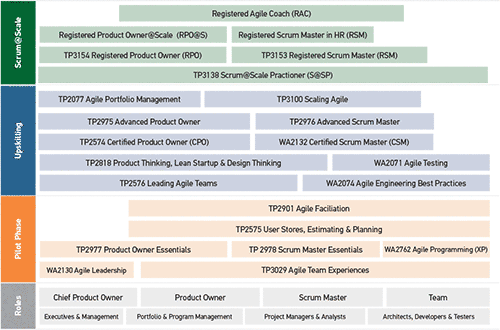Agile Foundations
Our most popular Agile workshop for Agile teams or individuals looking to advance their Agile skills.
Teams learn how to apply Agile methods to their projects successfully. Participants will learn the Agile Development Lifecycle, lead groups through Agile ceremonies, and understand techniques and practices to successfully facilitate and execute project deliverables. All while learning necessary Agile leadership skills such as Servant Leadership, Facilitation, and the Soft Skills required to make these roles a success.
Attendees will gain insight on how to bridge the gap between traditional and Agile Project Management. To ensure relevant learning occurs, attendees will kick off this course by brainstorming many real-world issues they face daily as members of a transitioning Agile organization. Participants use real-life projects to build Agile skills. This workshop is 40% lecture and 60% hands-on, real-world exercises.
This is a must-have workshop for anyone transitioning to Agile!
Learning Objectives
- Introduce Agile and provide examples of why an organization would choose to implement an Agile framework
- Understand the Servant Leadership style and why it is critical.
- Review Agile Teams Roles and Responsibilities
- Compare and contrast the common Agile Frameworks: Lean, Scrum, XP, and Kanban
- Demonstrate the Agile lifecycle
- Understand and demonstrate effective Story Writing and Estimation techniques
- Develop an understanding of the purpose of each Agile ceremony: (Release Planning, Backlog Refinement, Iteration Planning, Daily Standups, Demos and Retrospectives)
- Demonstrate facilitation of each Agile ceremony
What You’ll Learn
Agile Overview
-
- Introductions
- Overview of Agile
- Why Agile
- Agile Manifesto
- Agile Principles
- Activity: Mapping Principles to Manifesto
Agile Frameworks
-
- Lean
- Scrum
- Kanban
- Extreme Programming
The Agile Team
-
- The Agile Team
- Servant Leadership defined and expectations
- Servant Leadership vs. Command and Control
- Defining Self-Organized Teams
- Agile Roles – Product Owner
- Agile Roles – ScrumMaster
- Agile Roles – The Team
Agile Product Backlogs
-
- Agile Delivery Process
- Agile Requirements Levels
- Progressive Elaboration
Effective User Stories
-
- Work item levels: THEME \EPIC \ STORY
- User Stories deep-dive
- User Stories: Examples
- Guidelines for User Stories
- User Stories: I-N-V-E-S-T
- Workshop: Correcting User Stories
- Workshop (Online Real Estate) Part 1 – Writing User Stories
- Story Mapping
- Workshop (Online Real Estate) Part 2- Utilizing Story maps to generate stories
Acceptance Criteria\Test
-
- What is Test-Driven Development (TDD)
- Acceptance Criteria vs. Acceptance Test
- Why Acceptance Criteria?
- Documenting Acceptance Criteria\Test
- The Gherkin Format
- Definition of Done (DoD)
- Workshop (Online Real Estate) – Writing Acceptance Criteria
Estimating
-
- Estimating Techniques
- Sizing Stories
- Why Story Points
- Facilitating Planning Poker
- Activity (Thanksgiving Dinner) – Sizing Stories
Backlog Prioritization
-
- Backlog Prioritization Techniques
- Estimating – Business Value
- MoSCoW Analysis
- Value Risk (6 cell\9 cell models)
- Workshop (Online Real Estate) – Prioritize Stories
Building a Release Plan
-
- Building a Release Plan
- Team Velocity
- Release Planning
- Sample Release Plan
- Workshop – Create a release plan
Backlog Refinement
-
- Backlog Refinement Fundamentals
- Definition of Ready (DoR)
- Decomposing User Stories
- S-P-I-D-E-R Method
- Facilitating Refinement Sessions
- Workshop (Online Real Estate) – Refine the backlog
Iteration Planning
-
- Iteration Planning
- Break Down All Tasks
- The Team’s Definition of ‘Done’
- Capacity Planning
- Facilitating Iteration Planning Sessions
- Workshop Online Real Estate) – Plan your first iteration\capacity plan
Iteration Execution
-
- Daily Standup
- Task boards
- Workshop – Managing Tasks
Iteration Demos & Retrospectives
-
- Iteration Demo
- Iteration Retrospectives
- Creating, Monitoring, & Maintaining an improvement backlog
- Workshop: Practice a Retrospective
Metrics
-
- Metrics: Velocity Trends
- Metrics: Forecast vs. Completed
- Metrics: Burn-up Charts
- Metrics: Burn-Dow Charts
- Lead Time\Cycle Time
- How to use Metrics to achieve results
Who Should Attend?
-
- Team Members (Developers, Testers, Business Analysts, Architects…)
- Scrum Masters
- Product Owners
- Leaders, Managers
- Stakeholders
This team training is targeted at all roles and is intended for teams to attend together. All team members, including developers, testers, BAs, DBAs, business users, Scrum Masters, and Product Owners, should attend to gain the necessary core skills required to be on an Agile team. Training will achieve the highest level of effectiveness if Scrum Masters and Product Owners are in attendance with their team. Participants will experience agile practices, iterative delivery of value, and relentless improvement from all perspectives within the team.
